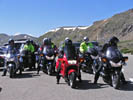
Colorado Weather
|
Colorado Weather |
The purpose of this page is to give you a general idea of the weather conditions in Colorado during the riding season.
Rain/Temperature.The summer precipitation in the high country is usually in the form of scattered afternoon showers which at higher elevations can cause hypothermia if you aren't wearing protective gear such as a rain suit, Aerostitch, or leathers. Since the temperature decreases 1-2 degrees per 1000 feet of elevation gain it can be hot in Denver and very cool on the high mountain passes, especially if it is windy, raining, or snowing. (We've ridden in snow in early June and September above 10,000'.) Night time temperatures above 9,000 feet, where many campgrounds are located, can result in frost on the pumpkin.
To help you decide what types of clothing and sleeping bags to pack, click here for a chart of average temperatures and precipitation around Colorado. You will notice a great variation in weather depending on elevations and geographic locations. The Ride the Divide, held in July, hits 11 of the places on the chart with the high temperatures varying from 82 (Pagosa Springs) to 66 (Wolf Creek Pass), the low temperatures from 47 (Estes Park) to 36 (Leadville), days with more than 0.1 inches of precipitation from 8 (Wolf Creek) to 3 (Buena Vista), and inches of precipitation from 3.6 (Wolf Creek) to 1.2 (Kremmling).
Motorcycle riding in Colorado requires planning for a variety of temperature and precipitation. Layers work best. Synthetics like capilene and Polartec for cool and wet conditions, cotton for warm and dry. Outdoor stores like REI and Eastern Mountain Sports carry a good selection of clothing that works as well for motorcycling as it does for hiking and cross country skiing. And it's hard to go wrong with an Aerostitch riding suit and a Widder electric vest. Stay warm and dry to stay happy and safely alert.
High Alititude. At elevations from 8,000-10,000 feet above sea level, oxygen is approximately 45% less dense and there is 50-80% less humidity in the air. Nearly everyone from lower elevations will notice shortness of breath and some will also experience fatigue, dizziness, headaches, and nausea. Most people will adjust to the altitude within 48-72 hours, during which time the American Heart Association of Colorado suggests that visitors follow these tips: eat lightly, drink plenty of water, avoid alcohol, get plenty of rest, and keep physical exertion to a minimum. Also suggested is to carry and use asprin/ibuprofen as needed and directed.
Be prepared like a Boy Scout. That will help to make your motorcycling a lot more safe and enjoyable.
Back to Ride Colorado Riding Tips page